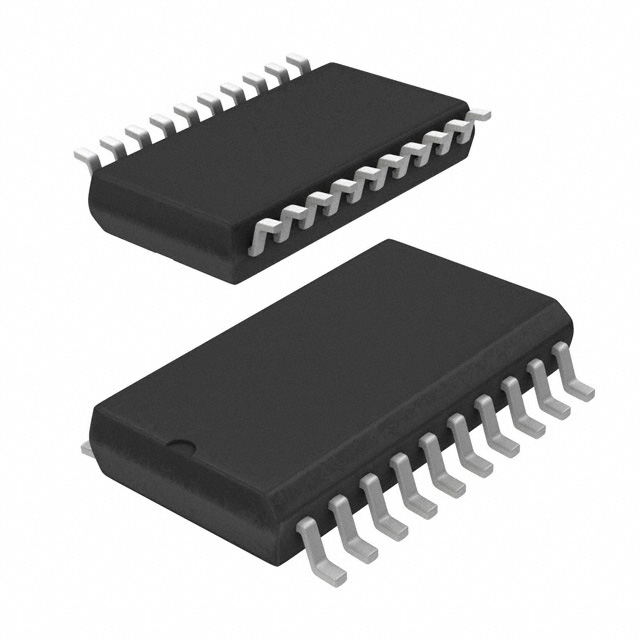Подробную информацию о продукте см. в характеристиках.

Encyclopedia Entry: 74HC373D
Product Overview
Category
The 74HC373D belongs to the category of integrated circuits (ICs) and specifically falls under the group of flip-flops.
Use
This IC is commonly used for storing and transferring data in digital systems. It serves as an octal transparent latch with three-state outputs.
Characteristics
- Octal transparent latch
- Three-state outputs
- High-speed operation
- Low power consumption
- Wide operating voltage range
Package and Quantity
The 74HC373D is available in a standard dual in-line package (DIP) with 20 pins. It is typically sold in reels or tubes, containing multiple units per package.
Essence
The essence of the 74HC373D lies in its ability to store and transfer data efficiently within digital systems. It provides a reliable solution for latching and outputting data in various applications.
Specifications
- Supply Voltage Range: 2V to 6V
- Input Voltage Range: 0V to VCC
- Output Voltage Range: 0V to VCC
- Operating Temperature Range: -40°C to +125°C
- Maximum Clock Frequency: 80 MHz
- Maximum Propagation Delay: 15 ns
Pin Configuration
The 74HC373D has a total of 20 pins, which are assigned specific functions. The detailed pin configuration is as follows:
- GND (Ground)
- D0 (Data Input 0)
- D1 (Data Input 1)
- D2 (Data Input 2)
- D3 (Data Input 3)
- D4 (Data Input 4)
- D5 (Data Input 5)
- D6 (Data Input 6)
- D7 (Data Input 7)
- G (Gated Latch Enable)
- LE (Latch Enable)
- O0 (Output 0)
- O1 (Output 1)
- O2 (Output 2)
- O3 (Output 3)
- O4 (Output 4)
- O5 (Output 5)
- O6 (Output 6)
- O7 (Output 7)
- VCC (Supply Voltage)
Functional Features
The 74HC373D offers the following functional features:
- Octal transparent latch with three-state outputs
- Data inputs (D0-D7) for storing information
- Latch enable (LE) input for controlling data transfer
- Gated latch enable (G) input for additional control
- Three-state outputs (O0-O7) for flexible data output
Advantages and Disadvantages
Advantages
- High-speed operation allows for efficient data handling
- Low power consumption ensures energy efficiency
- Wide operating voltage range provides versatility in different systems
- Three-state outputs allow for easy integration into bus systems
Disadvantages
- Limited number of data inputs (8 bits)
- Not suitable for applications requiring larger data storage capacity
Working Principles
The 74HC373D operates based on the principles of flip-flops. When the latch enable (LE) input is high, the data inputs (D0-D7) are latched and stored internally. The gated latch enable (G) input further controls the transfer of data to the outputs (O0-O7). When the G input is low, the outputs are in a high-impedance state, allowing other devices to drive the bus lines.
Detailed Application Field Plans
The 74HC373D finds extensive use in various digital systems and applications, including but not limited to:
- Microprocessor-based systems
- Data storage and transfer systems
- Address decoding circuits
- Bus interface units
- Control and timing circuits
Alternative Models
For those seeking alternatives to the 74HC373D, the following models provide similar functionality:
- SN74LS373: Low-power Schottky version
- CD74HC373: CMOS version with improved noise immunity
- MC74HC373: Motorola's equivalent model
These alternative models can be considered based on specific requirements and compatibility with existing systems.
In conclusion, the 74HC373D is a versatile integrated circuit that serves as an octal transparent latch with three-state outputs. Its high-speed operation, low power consumption, and wide operating voltage range make it suitable for various digital applications. However, its limited data input capacity may restrict its use in certain scenarios. Understanding its pin configuration, functional features, advantages, disadvantages, working principles, application field plans, and alternative models allows for informed decision-making when incorporating the 74HC373D into digital designs.
Перечислите 10 распространенных вопросов и ответов, связанных с применением 74HC373D в технических решениях.
Sure! Here are 10 common questions and answers related to the application of 74HC373D in technical solutions:
Q: What is the 74HC373D? A: The 74HC373D is a high-speed octal transparent latch with 3-state outputs, commonly used in digital systems.
Q: What is the purpose of the 74HC373D? A: The 74HC373D is used to store and control the flow of data in digital circuits. It can latch and hold data until it is updated or released.
Q: How many bits can the 74HC373D latch? A: The 74HC373D can latch 8 bits of data, as it is an octal latch.
Q: What is the maximum operating voltage for the 74HC373D? A: The 74HC373D has a maximum operating voltage of 6 volts.
Q: Can the 74HC373D handle both input and output signals? A: Yes, the 74HC373D can be used for both input and output signals. It has separate pins for input and output data.
Q: How does the 74HC373D handle 3-state outputs? A: The 74HC373D has a control pin (OE) that enables or disables the outputs. When disabled, the outputs enter a high-impedance state.
Q: Can I cascade multiple 74HC373D latches together? A: Yes, you can cascade multiple 74HC373D latches to increase the number of latched bits in your system.
Q: What is the typical propagation delay of the 74HC373D? A: The typical propagation delay of the 74HC373D is around 10 nanoseconds.
Q: Can I use the 74HC373D in both TTL and CMOS logic systems? A: Yes, the 74HC373D is compatible with both TTL and CMOS logic levels.
Q: Are there any specific precautions to take when using the 74HC373D? A: It is important to ensure that the power supply voltage does not exceed the maximum specified voltage, and to avoid exceeding the maximum current ratings of the device.
Please note that these answers are general and may vary depending on the specific application and requirements.

